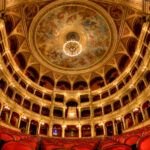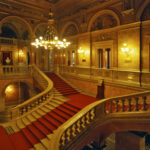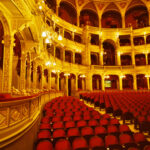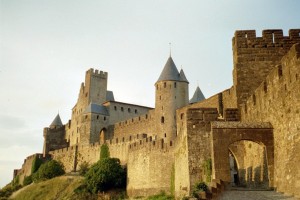Behold the grandeur of the Budapest Opera House, an architectural masterpiece nestled in the heart of Hungary. This spectacular UNESCO gem is a testament to the nation’s rich history and cultural heritage. With its ornate interiors, magnificent chandeliers, and impeccable acoustics, the Budapest Opera House stands as a symbol of artistic excellence.
Step inside and immerse yourself in a world of opulence and elegance. Every detail of this historic landmark exudes grandeur, from its marble staircase adorned with intricate carvings to its lavish golden auditorium.
Beyond its architectural splendor, the Budapest Opera House boasts a rich program of opera, ballet, and classical music, attracting renowned performers from across the globe. Whether you are a seasoned opera-goer or a first-time visitor, the mesmerizing performances within these hallowed halls are sure to captivate your soul.
Prepare to be transported to a bygone era of refined artistry and extraordinary talent. Join us as we delve into the fascinating history and enchanting allure of the Budapest Opera House, a cultural treasure that continues to inspire and awe audiences to this day.
History of the Budapest Opera House
The history of the Budapest Opera House dates back to the 19th century when Hungary was part of the Austro-Hungarian Empire. It was Emperor Franz Joseph I who commissioned the construction of the opera house, seeking to create a cultural haven in the heart of Budapest. The building was designed by renowned Hungarian architect Miklós Ybl, who drew inspiration from a variety of architectural styles, including Renaissance and Baroque.
The construction of the opera house began in 1875 and took nearly a decade to complete. The grand opening ceremony took place on September 27, 1884, with a performance of Ferenc Erkel’s opera, “Bánk bán.” Since then, the Budapest Opera House has been a thriving center for the performing arts, hosting countless world-class productions and attracting audiences from around the globe.
Architecture and design of the Budapest Opera House
As you step inside the Budapest Opera House, you are immediately transported to a world of opulence and elegance. Every detail of this historic landmark exudes grandeur, from its marble staircase adorned with intricate carvings to its lavish golden auditorium. The auditorium, with its horseshoe-shaped layout, features plush velvet seats and a stunning ceiling painting by Károly Lotz, depicting scenes from Greek mythology.
One of the most iconic features of the Budapest Opera House is its breathtaking chandelier. Weighing in at over three tons and adorned with thousands of crystals, this magnificent centerpiece adds an extra touch of glamour to the already awe-inspiring surroundings. The acoustics of the opera house are also legendary, thanks to the carefully designed domed ceiling and intricate sound system, ensuring that every note resonates with perfect clarity.
Notable performances and artists at the Budapest Opera House
Over the years, the Budapest Opera House has played host to an impressive lineup of world-renowned performers and productions. From opera legends like Luciano Pavarotti and Maria Callas to ballet stars like Rudolf Nureyev and Margot Fonteyn, the stage of the Budapest Opera House has witnessed countless unforgettable performances.
One of the most celebrated productions in the history of the Budapest Opera House is Giuseppe Verdi’s “Aida,” which has been performed here numerous times to critical acclaim. The opera house is also famous for its productions of works by Hungarian composers, including Béla Bartók and Zoltán Kodály. Whether you’re a fan of opera, ballet, or classical music, the Budapest Opera House offers a diverse program that caters to all tastes.
Tips for visiting the Budapest Opera House
If you’re planning a visit to the Budapest Opera House, here are a few tips to help you make the most of your experience. Firstly, it’s advisable to book your tickets in advance, especially for popular performances. The opera house offers a range of seating options, from affordable balcony seats to premium orchestra seats, so you can choose according to your budget and preference.
When attending a performance at the Budapest Opera House, it’s customary to dress elegantly. While there is no strict dress code, most guests opt for smart attire, such as suits or cocktail dresses. This adds to the overall sense of occasion and enhances the atmosphere of the evening.
Nearby attractions and activities in Budapest
While the Budapest Opera House is undoubtedly a must-visit attraction in the Hungarian capital, there are plenty of other sights and activities to explore in the vicinity. Just a short walk away is the iconic Hungarian Parliament Building, a stunning example of Neo-Gothic architecture. You can also take a leisurely stroll along the banks of the Danube River, admiring the breathtaking views of the city.
For those interested in history and culture, a visit to Buda Castle is highly recommended. This UNESCO World Heritage Site houses the Budapest History Museum and the Hungarian National Gallery, offering a fascinating glimpse into the country’s past. And of course, no visit to Budapest would be complete without indulging in the city’s famous thermal baths, such as the Széchenyi Thermal Bath or the Gellért Thermal Bath.
How to get tickets for performances at the Budapest Opera House
Getting tickets for performances at the Budapest Opera House is relatively straightforward. You can purchase them online through the official website or at the box office on the day of the performance, subject to availability. It’s worth noting that tickets for popular shows tend to sell out quickly, so it’s advisable to book in advance to secure your seats.
The Budapest Opera House also offers guided tours, providing a behind-the-scenes glimpse into the inner workings of this magnificent institution. Led by knowledgeable guides, these tours take you through the various areas of the opera house, including the stage, the dressing rooms, and the orchestra pit. It’s a unique opportunity to gain insight into the world of opera and ballet and learn about the rich history of the Budapest Opera House.
The impact of the Budapest Opera House on Hungarian culture
The Budapest Opera House holds a special place in the hearts of Hungarians, as it has played a significant role in shaping the nation’s cultural identity. Since its opening in 1884, the Opera House has been a beacon of artistic expression, showcasing the immense talent of Hungarian composers, musicians, and performers.
-
Preserving Hungarian Musical Heritage
The Budapest Opera House has been instrumental in preserving and promoting Hungarian musical heritage. It has served as a platform for showcasing the works of renowned Hungarian composers such as Franz Liszt, Béla Bartók, and Zoltán Kodály. These composers have left an indelible mark on the world of classical music, and their compositions continue to be celebrated within the walls of the Opera House.
The Opera House also hosts productions of traditional Hungarian operas, such as Ferenc Erkel’s “Bánk Bán” and Imre Kálmán’s “Die Csárdásfürstin.” These performances keep alive the rich tradition of Hungarian opera and allow audiences to experience the unique cultural heritage of the country.
-
Nurturing Talent and Artistic Excellence
The Budapest Opera House has nurtured countless talented performers, providing them with a platform to showcase their skills and launch their careers on an international stage. Many renowned opera singers, ballet dancers, and musicians have started their journey at the Budapest Opera House, honing their craft under the guidance of experienced professionals.
The Opera House’s commitment to artistic excellence is reflected in its rigorous training programs and the meticulous attention given to the selection of performers. This dedication to nurturing talent has contributed to the development of a vibrant artistic community in Hungary and has placed the Budapest Opera House on the global map as a center of excellence.
-
Cultural Icon and Tourist Attraction
The Budapest Opera House is not only revered by Hungarians but also draws visitors from around the world. Its architectural beauty and rich cultural significance make it a must-visit destination for tourists and art enthusiasts alike. The opulent interiors, with their intricate details and lavish decorations, transport visitors to a world of elegance and sophistication.
The Opera House offers guided tours that provide a glimpse into its history and behind-the-scenes operations. Visitors can explore the grand auditorium, marvel at the stunning frescoes adorning the ceiling, and learn about the technical intricacies that contribute to the exceptional acoustics of the venue. These tours offer a unique opportunity to immerse oneself in the rich cultural heritage of Hungary and gain a deeper appreciation for the art of opera and ballet.
Conclusion: The timeless beauty of the Budapest Opera House
The Budapest Opera House stands as a testament to the power of art and its ability to transcend time. Its majestic presence and captivating performances continue to inspire audiences, transporting them to a world of beauty, passion, and emotion. As a UNESCO World Heritage site, the Budapest Opera House is not only a national treasure but a global symbol of artistic excellence.
Whether you are an opera aficionado or simply seeking to immerse yourself in the rich cultural heritage of Hungary, a visit to the Budapest Opera House is an experience that should not be missed. Let the grandeur of its architecture, the enchantment of its performances, and the passion of its artists leave an indelible mark on your soul. Discover why the Budapest Opera House has earned its rightful place as a spectacular UNESCO gem in the heart of Hungary.
You can visit the Budapest Opera House while on a Danube River cruise. You can visit on your own or join an excursion from your ship.
AMA Waterways cruises the Danube, with 7-night itineraries between Budapest and Nuremberg and Vilshofen to Budapest. New for 2024 is a round-trip Budapest cruise itinerary. Discover a wealth of art, history, and cultural treasures as you cruise to some of Europe’s most famous destinations.
Prices include the cruise, all meals, wine and beer with dinner, a 1-hour happy hour each evening, and Wi-Fi. Multi-choice Excursions are included.
Croisi River Cruises offers 3 – 7-day European River Cruises and is the oldest river cruise line in Europe as well as being family-owned. The cruise line has over 42 vessels cruising the waterways of Europe. Danube itineraries include a 5-day and 8-day round trip Vienna cruise on the Danube as well as a 6-day cruise between Passau and Budapest.
Prices include the cruise, all meals, beverage packages with alcoholic and non-alcoholic beverages, and Wi-Fi. Excursions are additional.
A-ROSA CRUISE LINE cruises the Danube, aboard the A-ROSA Donna and A-FLORA, featuring short river cruises with English and German language onboard. There are no fixed seating or table arrangements on board. All meals are served as a buffet. There are chefs at all meals with an open kitchen preparing these dishes as you watch – so everything is fresh.
The ships have bicycles with helmets on board for cycling tours. A-ROSA is also known for its superior spa facilities onboard. A-ROSA offers 4-night, 5-night, and 7-night round-trip Passau river cruise itineraries. There is also a 7-night round-trip Vienna itinerary. A-ROSA also allows children 15 and under to cruise free with their parents in the same cabin in Cat S and G cabins. They are limited triple cabins and 1 set of connecting cabins per deck on a few of their ships.
Prices include the cruise, all meals, beverage package with alcoholic and non-alcoholic beverages and Wi-Fi. Excursions are additional.
For more information on any of the Danube River cruise itineraries or other rivers, please call or email:713 240 6753 or 888 869 7907 jan@europeanbarging.com







